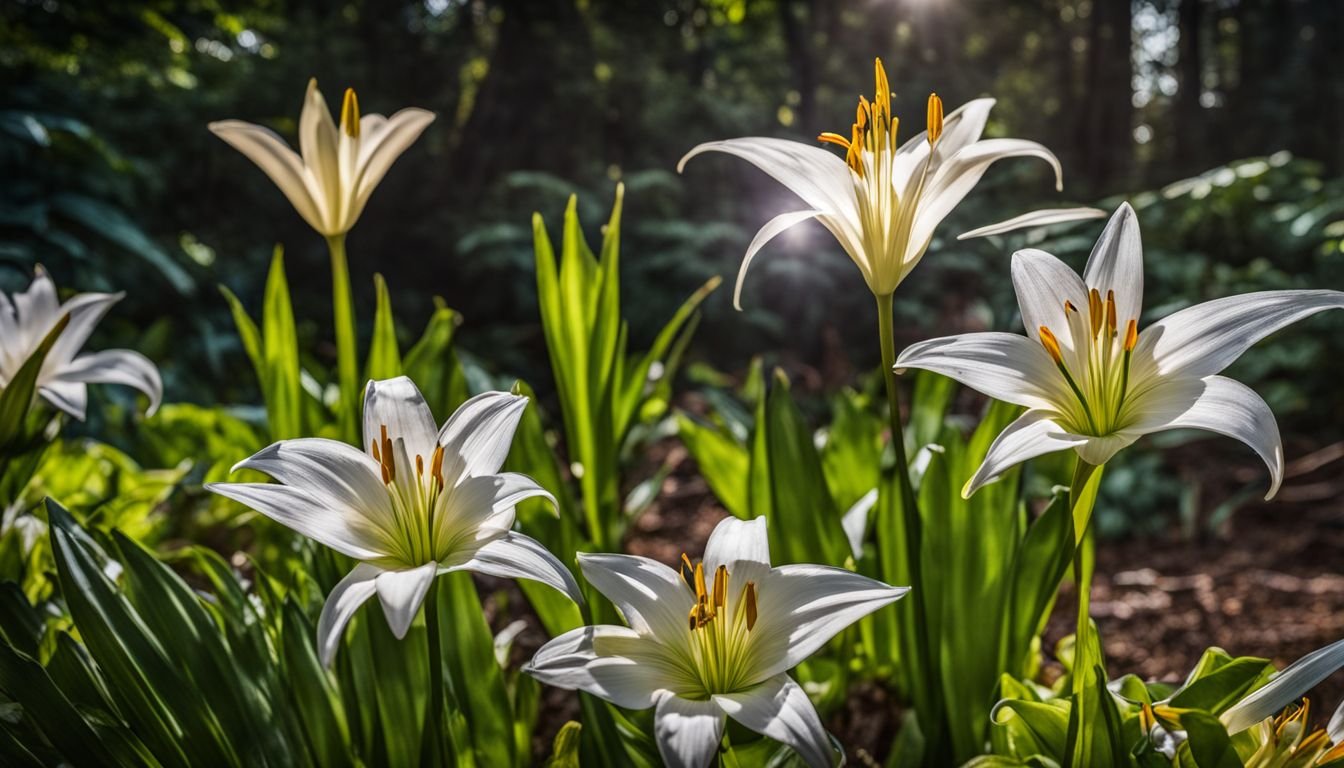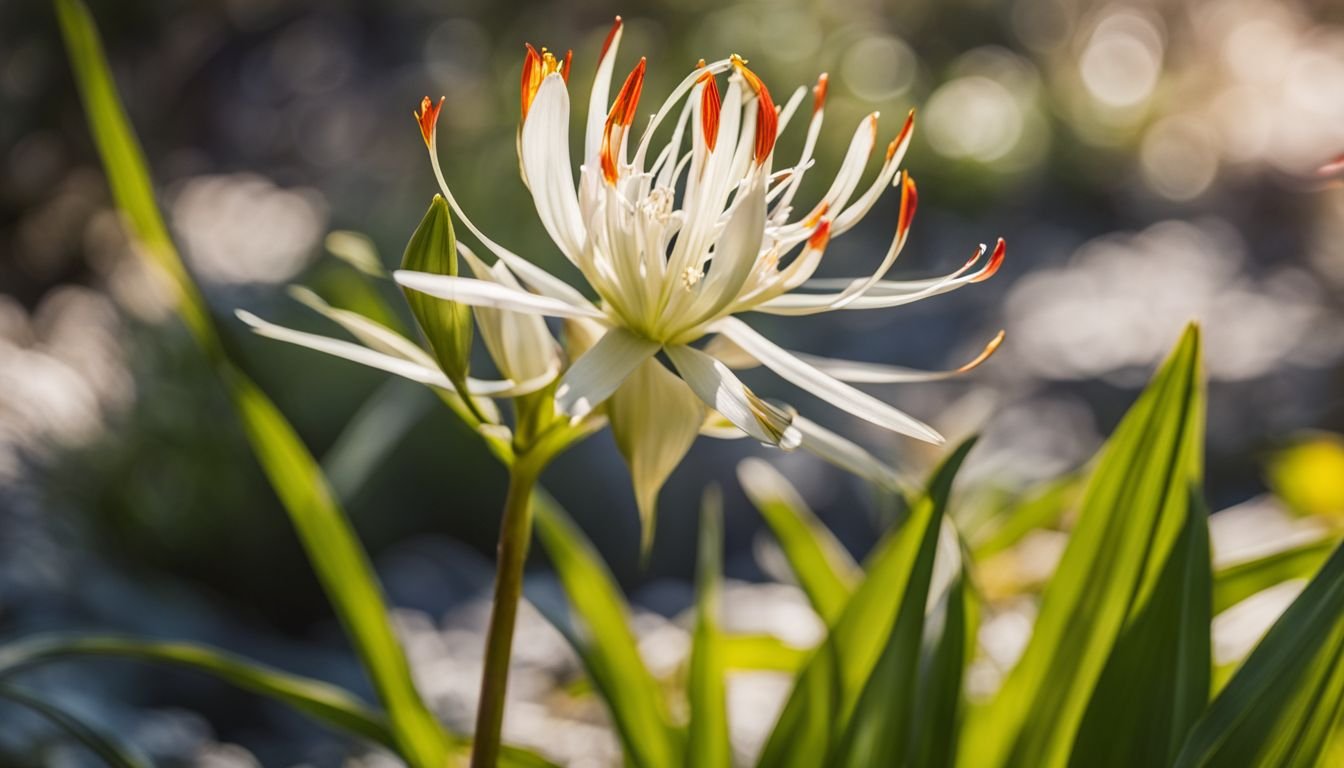Have you ever been on the hunt to sprinkle a bit of unique charm into your garden but found yourself scratching your head over what to pick? You’re not on your own, mate. Heaps of Aussies are chasing the dream of creating their very own backyard paradise yet get a tad overwhelmed by the smorgasbord of choices out there.
Among these treasures is an often overlooked beauty: the Rock Lily Flower, officially known as Arthropodium cirratum or more colloquially, the New Zealand Rock Lily. This little ripper is a true dazzler with its grey-green foliage and delicate white flowers that bring gardens to life from late spring.
We’ve been in those shoes, scouring high and low for that perfect touch to our green spaces and stumbled upon this resilient plant. We were chuffed to discover it’s not just about surviving but thriving in all sorts of conditions – from baking in full sunlight to lounging in partial shade – making it a deadset winner for those tricky spots in Aussie gardens.
Keen to help you navigate through growing and caring for these beauts, we’ve knocked together all the essential steps and insights you need. From picking the right nook in your garden or potting them indoors, right through ensuring they put on a spectacular show, our guide has got you covered.
Ready to give your garden a fair dinkum transformation? Let’s crack on!
Key Takeaways
- When planting Rock Lily flowers, choose a site with partial shade and good drainage to prevent root rot and ensure they flourish.
- Regular care is crucial; water them correctly, avoid overwatering, use organic mulch for moisture retention, remove old leaves, and protect from pests like orchid beetles and aphids by using natural remedies or safe deterrents.
- Improve the soil with organic matter such as compost before planting. For potted Rock Lilies, pick a container twice as large as the plant to promote growth whilst ensuring excellent drainage.
- Fertilising during autumn and spring helps prepare Rock Lilies for their growth spurts and blooming periods. Keep them away from overly moist areas to prevent diseases.
- Monitor your Rock Lily flowers for signs of stress or disease. Intervene quickly with gentle care techniques if problems arise to maintain their health and vibrant blooms.
Steps to Growing Rock Lily Flowers in Australia

We all want our gardens to burst with the vibrant petals of Rock Lily Flowers, known as Dendrobium speciosum. To make this happen, selecting a spot with partial shade is crucial because too much sun can harm these beauties.
Good dirt that drains well sets the stage for their roots to spread and anchor firmly. When we get our hands dirty and plant them, ensuring they get just the right amount of water becomes our next task.
Not too little, so they don’t dry out; not too much, preventing harm to aquatic organisms in nearby water features from low oxygen levels caused by overwatering.
Using organic mulch helps keep their feet cool and moist as they grow. This layer acts like a blanket that also feeds the soil as it breaks down. We must watch out for signs of stress or disease and act quickly with gentle care techniques if problems arise.
With patience and attention, we will see them thrive, attracting pollinators like bees and butterflies to our garden oasis.
Choosing the Right Location and Soil
Selecting the perfect spot for your Rock Lily flowers is crucial. These plants love a balance of sunlight and shade, thriving best where they can bask in the morning light but stay cool under afternoon shadows.
This mix ensures they get enough energy without scorching their delicate petals. For garden enthusiasts living near the coast or with shaded pool areas, Rock Lilies make an excellent choice due to their adaptability in these unique environments.
Soil quality plays a pivotal role too. While Rock Lilies are not fussy and can grow in various soil types, enriching the ground with organic improvers enhances their growth. Adding compost or decayed vegetation into the soil before planting creates a rich, nourishing bed that supports healthy root development.
Ensuring proper drainage is key as well; soggy conditions spell trouble by promoting root diseases like rotting—which our beloved lilies detest. Thus, steering clear of overly wet spots will keep them happy and flourishing.
Planting and Watering Techniques
We all know that getting our rock lily flowers to grow starts with planting them right. Pick a sunny spot that gets some shade during the day. Make sure the soil is rich and drains well by mixing in some quality improver and plant food before you place your plants in the ground.
Rock lilies love clinging onto stones, so setting them up near rocks or in stone gardens can really help them thrive.
Watering these beauties comes next but doesn’t drown them! These plants like their soil moist but not soggy. Give them a good drink early in the morning so they’re ready to face the sun.
Don’t forget, as seasons change from cooler to warmer months, your watering habits should adjust too. Keep an eye on rainfall and cut back on watering if nature’s already done the job for you.
Care involves more than just water though; it means keeping an eye out for leaves that look past their prime or any signs of distress and gently removing those parts from your plant.
This keeps your rock lilies looking fresh and encourages healthier new growth, ensuring they keep flowering beautifully year after year.
Care and Maintenance Tips
Rock Lily flowers thrive with a bit of love and the right care. To keep them happy, we make sure to remove old or damaged leaves. This not only keeps the plants looking fresh but also helps prevent disease.
We give them a boost by feeding them fertiliser during autumn and spring. These seasons are perfect because they prepare the plant for growth spurts and blooming periods.
We avoid placing our Rock Lilies in overly moist areas since this can lead to root trouble. Instead, we pot them in containers that are big enough, using quality soil mixtures like Yates Premium Potting Mix With Dynamic Lifter.
This special mixture supports strong growth by providing essential nutrients. For those of us growing Rock Lilies in pots, it’s important to choose ones at least twice as large as the plant itself to allow room for growth while ensuring excellent drainage and preventing water from pooling around the roots.
Joining gardening communities like Yates Garden Community offers extra tips and tricks directly to our inbox, making it easier for us to enjoy vibrant blooms year after year.
Common Challenges in Growing Rock Lily Flowers and Solutions

Growing Rock Lily flowers in Australia offers many joys but comes with its challenges. We’ll tackle some common issues and provide solutions to keep your garden thriving.
- Black and orange orchid beetles attack new growth: These pests can severely damage young NSW Rock Lily plants. Catching them early is key. Check your plants often, especially the new shoots. You can gently remove beetles by hand if you spot them or use horticultural soap as a safe deterrent.
- Root rot due to excess moisture: Rock Lilies don’t like wet feet. Ensure they are planted in well-draining soil and keep them away from overly damp areas of your garden, such as near water features or lakes where splashes might keep the ground soggy. If you suspect root rot, improve drainage by adding coarse sand or grit to the soil around your plant.
- Damage from too much sun or not enough light: Finding the sweet spot for these beauties is essential. They flourish in part shade, enjoying protection during the hottest parts of the day while still receiving enough light to bloom beautifully. Observe how sunlight moves through your garden and choose a spot that matches these conditions.
- Choosing the wrong soil: These flowers thrive in rich, loamy soil that retains moisture without remaining wet. If your garden’s natural soil doesn’t match this description, amend it with organic matter such as compost before planting your Rock Lilies.
- Cold weather sensitivity: The New Zealand Rock Lily doesn’t fare well in cooler climates found in some parts of Australia. Protect these plants during cold snaps by covering them with horticultural fleece or moving potted ones to sheltered spots.
- Keeping pests at bay naturally: Aphids and other small insects might also pose a threat to your Rock Lilies. Introduce beneficial insects like ladybirds into your garden, which feed on aphids but leave plants unharmed, encouraging a healthy ecosystem around your flowers.
With these strategies, we can overcome the challenges of growing Rock Lily flowers in our gardens, ensuring they remain vibrant and healthy contributors to our outdoor spaces.
Tips for Enhancing the Bloom of Rock Lily Flowers
To boost the bloom of Rock Lily flowers, we make sure they get the right amount of sunlight. These beauties thrive in full sun to part shade. We find a spot where they can bask in the morning light but stay cool during the harsh afternoon rays.
This balance keeps them happy and encourages more vibrant blooms.
Feeding Rock Lilies with fertiliser during autumn and spring supports their growth and flowering. We use a balanced feed, suitable for lavenders and other ornamentals, which fuels their need for nutrients without overwhelming them.
Regularly removing older or damaged leaves allows new ones to flourish, ensuring our Rock Lilies always look their best.
“The beauty of a garden lies not just in its blooms but in its care.”
Moving on, let’s delve into how to keep these stunning plants healthy all year round.
Conclusion: Enjoying the Beauty of Rock Lily Flowers in Australia
Growing and caring for Rock Lily Flowers brings a unique charm to Australian gardens. With the right spot, soil improvements like Yates Dynamic Lifter, and consistent care, these plants thrive.
They light up spaces with their tiny white blooms from late spring to early summer. Keeping them healthy means avoiding wet spots and removing older leaves. Joining communities such as the Yates Garden Club offers even more tips for success.
This endeavor adds beauty not just to our yards but also enriches our gardening journey in Australia.
FAQs
1. What are the best conditions for growing Rock Lily flowers in Australia?
Rock Lily flowers thrive in well-drained soils and areas that receive plenty of sunlight, making them perfect for Australian gardens. They do well alongside native plants like eucalyptus and can add beauty to water gardens.
2. Can I grow Rock Lily flowers indoors or near my aquarium?
Yes, you can grow Rock Lily flowers as indoor plants if they get enough light. They also make an attractive addition to areas around your aquarium, adding a touch of nature’s beauty without harming aquatic life.
3. How often should I water my Rock Lily plants?
Rock Lilies need regular watering but don’t like to sit in wet soil. Make sure their soil is moist but well-drained, especially during dry spells, similar to caring for olives or citrus trees.
4. Are there any specific pests or problems I should watch out for with Rock Lily flowers?
While generally hardy, keep an eye out for common garden pests that might also be attracted to other garden favorites like lavandula (lavender), mint, and bulbous fruits and herbs.
5. Can I plant other types of plants with my Rock Lillys in a mixed bed or garden?
Absolutely! Rock Lilies look stunning when planted alongside various herbs, fruits like olives and citrus trees, and even aromatic plants such as lavender (lavandula) and eucalyptus which not only complement each other visually but also help create a more diverse ecosystem in your garden.
